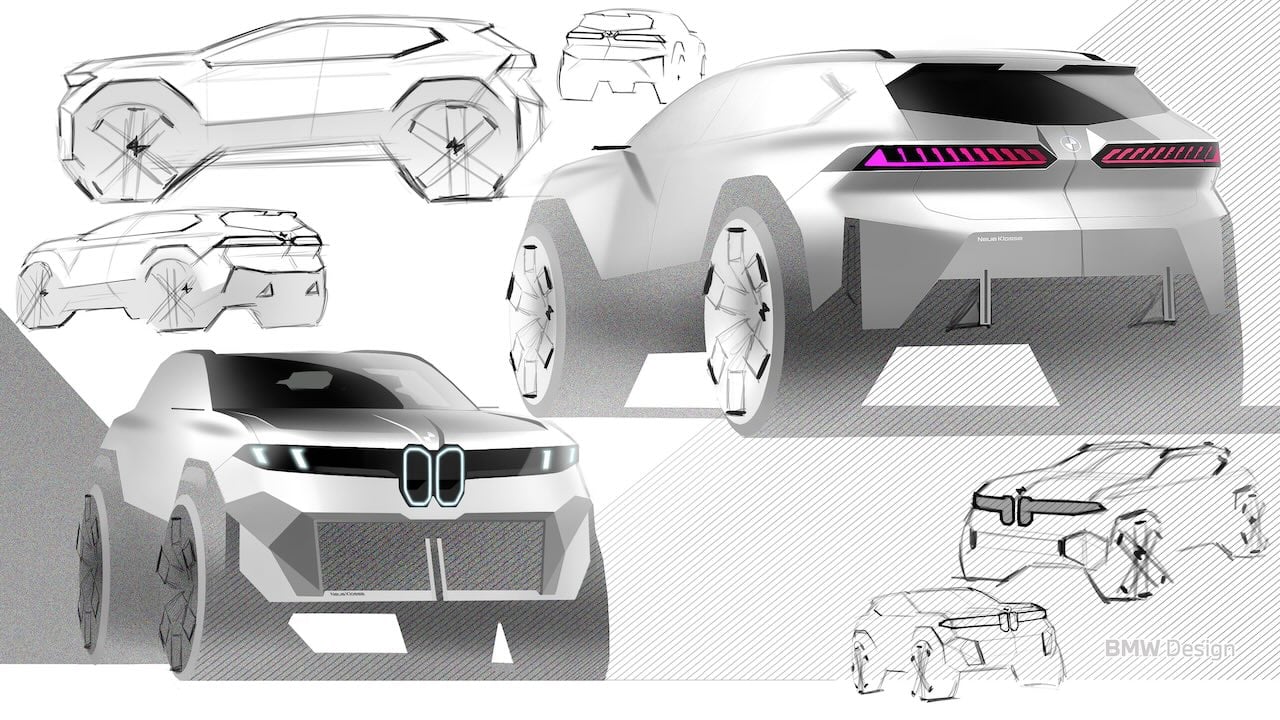BMW’s design philosophy operates on a simple premise: emotion first, specs second. Adrian van Hooydonk, head of design, doesn’t mince words about this. Customers feel a product before they ever parse a data sheet.
Designer: BMW
This creates tension when sustainability enters the frame. Circular design has historically meant compromise, a sense of settling for less in service of doing good. The Neue Klasse series, especially the all-electric iX3, flips that script entirely. Van Hooydonk’s team treats circularity as a creative constraint that opens doors rather than closing them. “Circular products can’t feel like a compromise,” he explains. “They need to feel like more, not less.” The circular strategy addresses CO2 reduction at every manufacturing touchpoint, but the real shift happens upstream, in how designers conceptualize materials before a single prototype gets built. Sustainability becomes narrative architecture rather than regulatory compliance.
Designworks and the Benefit Mindset
Julia de Bono runs Designworks. The studio has shaped aircraft interiors, digital interfaces, and consumer products across every category imaginable.
Her philosophy centers on what she calls “benefit mindset,” and she draws an unexpected parallel to make the point. The Impossible Burger didn’t succeed by marketing sacrifice to environmentally conscious consumers. It succeeded by delivering an experience that stood alone. De Bono applies identical logic to automotive design: “Our role is to make the sustainable option not just equal, but superior in customer experience. We want circularity to bring more richness, more presence, more value.”
This reshapes everything about material selection at Designworks. The studio isn’t swapping petroleum plastics for recycled alternatives and calling it progress. Every material choice gets evaluated through tactile experience, visual storytelling, emotional resonance. The circular story becomes brand experience. Design maturity, in de Bono’s view, means infusing narrative from the start rather than bolting sustainability messaging onto finished products.
Materials That Tell a Story
The iX3 cabin demonstrates practical application of circular thinking at scale. PET-based mono-material seat covers deliver expected tactile comfort while radically simplifying end-of-life recycling. Secondary raw materials appear in dashboard surfaces, structural components, chassis elements. The real intelligence shows in disassembly optimization, where BMW engineers separation into products from day one, designing each element for clean post-use extraction.
Traditional luxury interiors layer materials in ways that make recycling contamination nearly inevitable. Leather bonds to foam bonds to structural substrate in combinations that defy clean separation. BMW’s approach designs for that moment fifteen years out when this vehicle reaches end of life. The seat foam separates from fabric covering separates from structural support. Each generation becomes feedstock for the next.
Luxury automotive has always communicated status through abundance. Leather, exotic woods, brushed metals stacked in combinations that signal premium positioning. BMW’s test: can circular materials carry that emotional weight while telling a different story? The mono-material fabrics, advanced eco-plastics, engineered weaves become new vocabulary. Early market response suggests buyers respond when sustainability weaves into ownership experience rather than presenting as trade-off.
Emotion as Strategy
Luxury buyers purchase stories, and BMW understands this dynamic better than most automakers. The circular narrative offers differentiation where performance specs have largely converged across competitors. Someone choosing the iX3 isn’t just acquiring efficient electric mobility. They’re buying into a design philosophy that treats resource consciousness as creative advantage rather than limitation.
Designworks extends this thinking to every touchpoint. Haptic feedback from interior controls, interface animations on cabin displays, the sound design of door closures: all reinforce circular narrative. Materials get selected for emotional response as much as technical performance. De Bono describes the result as “responsible abundance,” luxury that doesn’t require excess to register as premium.
Performance Through a Different Lens
Performance usually means horsepower and acceleration times, but BMW’s circular lens reframes the conversation entirely. Electric drivetrains deliver instant torque and low center of gravity, which liberates designers from packaging constraints that shaped combustion vehicles for a century. Skateboard platform architecture creates interior volumes that would have demanded much larger exterior dimensions in traditional layouts. The performance advantage becomes spatial, experiential, narrative.
Regional markets interpret this differently. American buyers equate automotive strength with physical presence, the ability to command road space and project capability. European and Asian markets often prioritize individual identity, advanced user experience, tech-forward interfaces. Circularity adapts to regional priorities by shaping silhouette, proportion, stance as carriers for localized story. “For us, circularity means shaping the silhouette, the proportions, and the presence,” notes a senior Designworks designer. “It’s not just technical. It’s aesthetic leadership.”
Global Design, Local Values
Designworks runs focus groups across China, North America, Europe, the Middle East. The question: how does sustainable design resonate differently across cultures?
In China, rapidly evolving tastes push toward bolder, more tech-driven expressions. North American markets still value physical presence, which sustainable materials and production must emphasize rather than diminish. BMW resists the temptation of unified global design language. Circularity becomes flexible toolkit, adapting to local values while maintaining consistent material philosophy underneath.
The Competitive Edge
BMW positions sustainability as competitive advantage rather than compliance cost, and the ambition extends well beyond current models. Circularity will shape silhouettes, interior architectures, the ways customers interact with vehicles across the next decade. For design observers tracking automotive evolution, the lesson reaches beyond Munich: sustainability constraints unlock creative solutions when treated as design opportunities rather than regulatory burdens.
Advanced materials combine with emotional storytelling and reimagined performance to create differentiation that competitors struggle to replicate. Resource consciousness becomes precursor to market leadership rather than barrier to it. The rest of the industry would benefit from studying how BMW weaves sustainability, narrative, and design freedom into something that registers as progress rather than sacrifice.
The post How BMW Designworks Turns Circularity Into Creative Fuel first appeared on Yanko Design.

